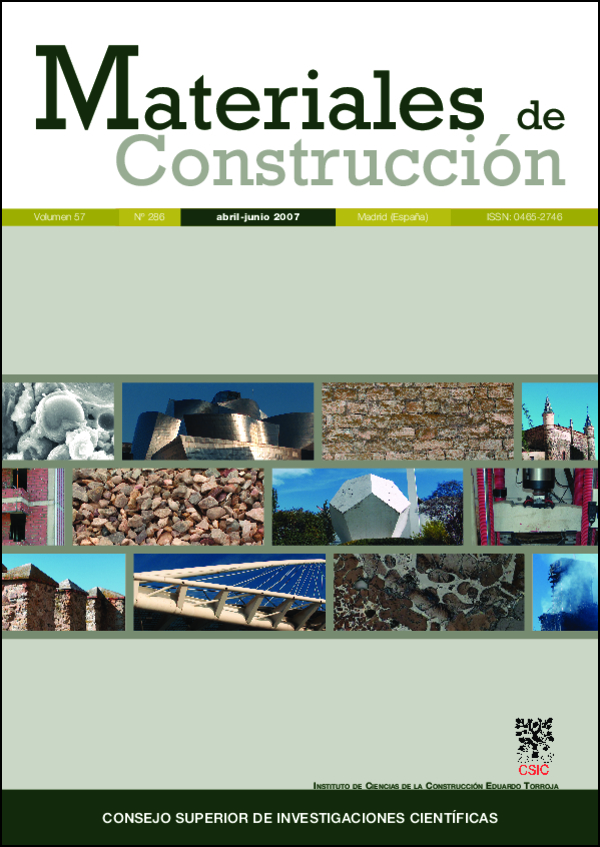High performance polymer concrete
DOI:
https://doi.org/10.3989/mc.2007.v57.i286.45Keywords:
polymer concrete, thermosetting resin, mechanical properties, microstructure, SEMAbstract
This paper studies the performance of concrete whose chief components are natural aggregate and an organic binder —a thermosetting polyester resin— denominated polymer concrete or PC. The material was examined macro- and microscopically and its basic physical and mechanical properties were determined using mercury porosimetry, scanning electron microscopy (SEM-EDAX), X-ray diffraction (XRD) and strength tests (modulus of elasticity, stress-strain curves and ultimate strengths). According to the results of these experimental studies, the PC exhibited a low density (4.8%), closed pore system and a concomitantly continuous internal microstructure. This would at least partially explain its mechanical out-performance of traditional concrete, with average compressive and flexural strength values of 100 MPa and over 20 MPa, respectively. In the absence of standard criteria, the bending test was found to be a useful supplement to compressive strength tests for establishing PC strength classes.
Downloads
References
(1) European Project BRPR-0CT98-078: Highly durable precast special concrete reinforced with non-metallic rebars, Plasticrete, febrero, 2002.
(2) Fowler, D. W.: “Polymers in Concrete - Where have we been and where are we going?”, en D. Fowler (ed.): Proceeding ICPIC’01, Hawai, 2001.
(3) Verleg, R. L.: “Corrosion resistant unsaturated polyester resins; an overview, by DSM-BASF Structural Resins”, Proceedings of the Reinforced Plastics Conference, Karlovy Vary, 1997, pp. 90-100.
(4) Czarnecki, L., Garbacz, A. y Lukowski, P., Clifton, J.: Optimization of polymer concrete composites, NISTIR 636, Maryland, 1999.
(5) Nanni, A.: “North American design guidelines for concrete reinforcement and strengthening using FRP: principles, applications and unresolved issues”, en J. G., Teng (ed.): Proceedings of the International Conference on FRP Composites in Civil Engineering, Hong- Kong, vol. 1 (2001), pp. 61-72.
(6) San-José, J. T. y Vegas, I.: “Find Meyer. Structural analysis of FRP reinforced polymer concrete material”, Constr. Build. Mater., 20 (2006), pp. 971-981. doi:10.1016/j.conbuildmat.2005.06.012
(7) San-José, J. T., Vegas, I. y Ferreira, A.: “Reinforced polymer concrete: physical properties of the matrix and static/dynamic bond behaviour”, Cem. Concr. Compos., 27 (9-10) (2005), pp. 934-944. doi:10.1016/j.cemconcomp.2005.06.004
(8) Czarnecki, L., Garbacz, A., Lukowski, P. y Clifton, J.: Optimization of polymer concrete composites. NISTIR 636, Maryland (USA), agosto, 1999.
(9) RILEM: Symposium on properties and tests methods for concrete-polymer composites, Oostende, 1995.
(10) Olivares, M., Laffarga, J., Galán, C. y Nadal, P.: “Evaluation of concrete mechanical strength through porosity”, Mater. Construcc., 54 (273) (2004), pp. 21-34.
(11) Spanish Instruction EHE. In Spanish, 1999.
(12) Abdel-Fattah, H. y El-Hawary, M. M.: “Flexural Behaviour of Polymer Concrete”, Constr. Build. Mater., 13 (1999), pp. 253-262.
(13) San-José, J. T. y Aguado, A.: “Influence of the viscoelastic nature of the polymer concrete in its structural behaviour”, en University of Minho (ed.): Proceedings of the International Symposium Polymers in Concrete. ISPIC’06, Guimaraes, 2006, pp. 69-83.
(14) Kwan-ho kim, Kyu-seok yeon, Nan-ji jin y Kwang-soo park: The investigation of the equivalent rectangular stress block for highstrength polymer concrete beams, ICPIC’01 Hawai (USA), 2001.
(15) Van Gemert, D., Knapen, E., Czarnecki, L. y Lukowski, P.: “Cement concrete and concrete Polymer composites: two merging worlds. A report from 11th ICPIC Congress in Berlin, 2004”, en University of Minho (ed.): Proceedings of the International Symposium Polymers in Concrete. ISPIC’06, Guimaraes (2006) pp. 1-15.
Downloads
Published
How to Cite
Issue
Section
License
Copyright (c) 2007 Consejo Superior de Investigaciones Científicas (CSIC)

This work is licensed under a Creative Commons Attribution 4.0 International License.
© CSIC. Manuscripts published in both the print and online versions of this journal are the property of the Consejo Superior de Investigaciones Científicas, and quoting this source is a requirement for any partial or full reproduction.
All contents of this electronic edition, except where otherwise noted, are distributed under a Creative Commons Attribution 4.0 International (CC BY 4.0) licence. You may read the basic information and the legal text of the licence. The indication of the CC BY 4.0 licence must be expressly stated in this way when necessary.
Self-archiving in repositories, personal webpages or similar, of any version other than the final version of the work produced by the publisher, is not allowed.
















